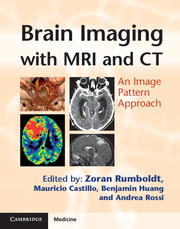Book contents
- Frontmatter
- Contents
- List of contributors
- List of abbreviations
- Preface
- Section 1 Bilateral Predominantly Symmetric Abnormalities
- Section 2 Sellar, Perisellar and Midline Lesions
- Section 3 Parenchymal Defects or Abnormal Volume
- Section 4 Abnormalities Without Significant Mass Effect
- Section 5 Primarily Extra-Axial Focal Space-Occupying Lesions
- Section 6 Primarily Intra-Axial Masses
- 152 Acute Infarction
- 153 Glioblastoma Multiforme
- 154 Therapy-Induced Cerebral Necrosis (Radiation Necrosis)
- 155 Non-Hemorrhagic Metastases
- 156 Cerebral Abscess
- 157 Cerebral Toxoplasmosis
- 158 Primary CNS Lymphoma
- 159 Tumefactive Demyelinating Lesion
- 160 Tuberculoma
- 161 Oligodendroglioma
- 162 Low-Grade Diffuse Astrocytoma
- 163 Gliomatosis Cerebri
- 164 Mitochondrial Myopathy, Encephalopathy, Lactic Acidosis, and Stroke-Like Episodes (MELAS)
- 165 Pleomorphic Xanthoastrocytoma (PXA)
- 166 Ganglioglioma
- 167 Neurocysticercosis – Parenchymal
- 168 Dilated Perivascular Spaces
- 169 Neuroepithelial Cyst
- 170 Subependymal Giant Cell Astrocytoma (SEGA)
- 171 Subependymoma
- 172 Ependymoma
- 173 Pilocytic Astrocytoma
- 174 Medulloblastoma
- 175 Hemangioblastoma
- 176 Lhermitte–Duclos (Cowden Syndrome)
- 177 Hypertensive Hematoma
- 178 Amyloid Hemorrhage – Cerebral Amyloid Angiopathy
- 179 Cortical Contusion
- 180 Hemorrhagic Neoplasms
- 181 Hemorrhagic Venous Thrombosis
- 182 Arteriovenous Malformation
- 183 Cavernous Angioma (Cavernoma)
- Section 7 Intracranial Calcifications
- Index
- References
168 - Dilated Perivascular Spaces
from Section 6 - Primarily Intra-Axial Masses
Published online by Cambridge University Press: 05 August 2013
- Frontmatter
- Contents
- List of contributors
- List of abbreviations
- Preface
- Section 1 Bilateral Predominantly Symmetric Abnormalities
- Section 2 Sellar, Perisellar and Midline Lesions
- Section 3 Parenchymal Defects or Abnormal Volume
- Section 4 Abnormalities Without Significant Mass Effect
- Section 5 Primarily Extra-Axial Focal Space-Occupying Lesions
- Section 6 Primarily Intra-Axial Masses
- 152 Acute Infarction
- 153 Glioblastoma Multiforme
- 154 Therapy-Induced Cerebral Necrosis (Radiation Necrosis)
- 155 Non-Hemorrhagic Metastases
- 156 Cerebral Abscess
- 157 Cerebral Toxoplasmosis
- 158 Primary CNS Lymphoma
- 159 Tumefactive Demyelinating Lesion
- 160 Tuberculoma
- 161 Oligodendroglioma
- 162 Low-Grade Diffuse Astrocytoma
- 163 Gliomatosis Cerebri
- 164 Mitochondrial Myopathy, Encephalopathy, Lactic Acidosis, and Stroke-Like Episodes (MELAS)
- 165 Pleomorphic Xanthoastrocytoma (PXA)
- 166 Ganglioglioma
- 167 Neurocysticercosis – Parenchymal
- 168 Dilated Perivascular Spaces
- 169 Neuroepithelial Cyst
- 170 Subependymal Giant Cell Astrocytoma (SEGA)
- 171 Subependymoma
- 172 Ependymoma
- 173 Pilocytic Astrocytoma
- 174 Medulloblastoma
- 175 Hemangioblastoma
- 176 Lhermitte–Duclos (Cowden Syndrome)
- 177 Hypertensive Hematoma
- 178 Amyloid Hemorrhage – Cerebral Amyloid Angiopathy
- 179 Cortical Contusion
- 180 Hemorrhagic Neoplasms
- 181 Hemorrhagic Venous Thrombosis
- 182 Arteriovenous Malformation
- 183 Cavernous Angioma (Cavernoma)
- Section 7 Intracranial Calcifications
- Index
- References
Summary
Specific Imaging Findings
Perivascular spaces (PVS) show a well-defined oval, rounded, or tubular configuration with smooth margins and are commonly seen bilaterally in the supratentorial white matter with a radial orientation and in the basal nuclei (around the anterior commissure and in the midbrain). PVS appear on CT as hypodense areas, with similar attenuation as CSF. Calcifications or other associated abnormalities are not present. On MRI, their signal intensity also follows the CSF, being hypointense on FLAIR images, typically without any bright rim. Contrast enhancement is absent and there is water-like diffusivity on ADC maps. MR spectroscopy around dilated PVS shows normal spectra. In rare cases PVS may continuously enlarge to over 2 cm in size, frequently containing internal septations. The surrounding brain parenchyma generally has normal signal intensity; however, adjacent to dilated and enlarging PVS, hyperintense signal on FLAIR images may be present, likely representing reactive gliosis or spongiosis.
Pertinent Clinical Information
Small PVS (≤ 5 mm) are seen on high-resolution MRI in all age groups. Dilatation of PVS has been associated with aging. In healthy children, they are present in 25–30% of cases and must be considered a benign normal variant. They are usually asymptomatic and discovered incidentally. However, in the pediatric age group, prominent PVS are also well-known findings of mucopolysaccharidoses (types I and II). In those cases, PVS dilation specifically involves the corpus callosum, in addition to the periventricular white matter.
Information
- Type
- Chapter
- Information
- Brain Imaging with MRI and CTAn Image Pattern Approach, pp. 347 - 348Publisher: Cambridge University PressPrint publication year: 2012
